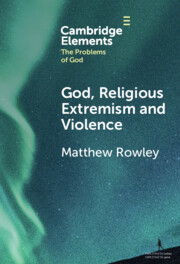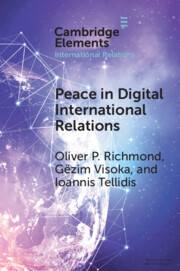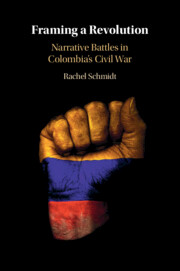87 results
The Dynamics of Herder-Farmer Conflicts in Plateau State, Nigeria, and Central Darfur State, Sudan
-
- Journal:
- African Studies Review , First View
- Published online by Cambridge University Press:
- 17 May 2024, pp. 1-30
-
- Article
- Export citation

God, Religious Extremism and Violence
-
- Published online:
- 22 February 2024
- Print publication:
- 21 March 2024
-
- Element
- Export citation
Post-growth peacebuilding
-
- Journal:
- Review of International Studies , First View
- Published online by Cambridge University Press:
- 15 February 2024, pp. 1-11
-
- Article
- Export citation
Toward an integrated approach for mental health and psychosocial support and peacebuilding in North-East Nigeria: programme description and preliminary outcomes from ‘Counselling on Wheels’
-
- Journal:
- BJPsych Open / Volume 9 / Issue 6 / November 2023
- Published online by Cambridge University Press:
- 12 October 2023, e190
-
- Article
-
- You have access
- Open access
- HTML
- Export citation
10 - Third-Party Peacemaking and Peacekeeping
- from Part IV - Diplomacy and Conflict
-
-
- Book:
- Understanding War and Peace
- Published online:
- 06 July 2023
- Print publication:
- 20 July 2023, pp 300-336
-
- Chapter
- Export citation
“The Country Is on One Leg”: An Analysis of Secondary Educated Youths’ Perceptions of the Risks, Challenges, and Opportunities of the Peacebuilding Process in Côte d’Ivoire
-
- Journal:
- African Studies Review / Volume 66 / Issue 3 / September 2023
- Published online by Cambridge University Press:
- 29 May 2023, pp. 745-776
-
- Article
-
- You have access
- Open access
- HTML
- Export citation
1 - Beyond Violence
-
- Book:
- Redefining Ceasefires
- Published online:
- 11 May 2023
- Print publication:
- 25 May 2023, pp 1-11
-
- Chapter
- Export citation
3 - Deconstructing Fambul Tok’s Discourse and Practice
-
- Book:
- Navigating Local Transitional Justice
- Published online:
- 13 July 2023
- Print publication:
- 11 May 2023, pp 68-95
-
- Chapter
- Export citation
Rethinking international intervention through coeval engagement: Non-formal youth education and the politics of improvement
-
- Journal:
- Review of International Studies , First View
- Published online by Cambridge University Press:
- 11 April 2023, pp. 1-22
-
- Article
-
- You have access
- Open access
- HTML
- Export citation

Peace in Digital International Relations
- Prospects and Limitations
-
- Published online:
- 21 March 2023
- Print publication:
- 06 April 2023
-
- Element
- Export citation
X - Framing Reintegration
-
- Book:
- Framing a Revolution
- Published online:
- 02 March 2023
- Print publication:
- 09 March 2023, pp 250-276
-
- Chapter
- Export citation
11 - Conclusion
- from Part III - Institutional Persistence
-
- Book:
- Undermining the State from Within
- Published online:
- 23 February 2023
- Print publication:
- 02 March 2023, pp 240-262
-
- Chapter
- Export citation
1 - Introduction
- from Part I - Foundations
-
- Book:
- Undermining the State from Within
- Published online:
- 23 February 2023
- Print publication:
- 02 March 2023, pp 3-32
-
- Chapter
- Export citation
7 - Transition, Peace, and Postwar Power in Central America
- from Part III - Institutional Persistence
-
- Book:
- Undermining the State from Within
- Published online:
- 23 February 2023
- Print publication:
- 02 March 2023, pp 153-179
-
- Chapter
- Export citation

Framing a Revolution
- Narrative Battles in Colombia's Civil War
-
- Published online:
- 02 March 2023
- Print publication:
- 09 March 2023
2 - Theorizing Wartime Institutional Change and Survival
- from Part I - Foundations
-
- Book:
- Undermining the State from Within
- Published online:
- 23 February 2023
- Print publication:
- 02 March 2023, pp 33-60
-
- Chapter
- Export citation
8 - Peace
-
- Book:
- Divided Environments
- Published online:
- 15 September 2022
- Print publication:
- 22 September 2022, pp 240-269
-
- Chapter
- Export citation
Introduction
-
-
- Book:
- Narratives of Mass Atrocity
- Published online:
- 01 September 2022
- Print publication:
- 08 September 2022, pp 1-33
-
- Chapter
-
- You have access
- Open access
- HTML
- Export citation
2 - Victim, Perpetrator, Hero
-
-
- Book:
- Narratives of Mass Atrocity
- Published online:
- 01 September 2022
- Print publication:
- 08 September 2022, pp 52-77
-
- Chapter
-
- You have access
- Open access
- HTML
- Export citation
Pastoralists and Violent Conflict along the Oromia–Somali Border in Eastern Ethiopia: Institutional Options toward Peacebuilding
-
- Journal:
- African Studies Review / Volume 65 / Issue 2 / June 2022
- Published online by Cambridge University Press:
- 07 July 2022, pp. 404-429
-
- Article
- Export citation



